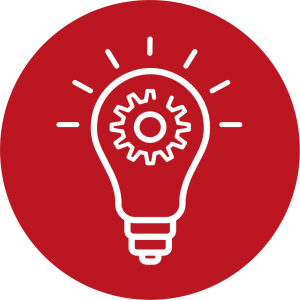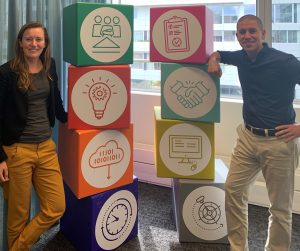
Josephine Verstappen. Job elsewhere.
Josephine Verstappen Member Programma Team (VSNU) Over 2.5 years ago I started working as a policy advisor Educational Innovation with


In mid-July, the working group EdTech for educational innovation started. It is the new working group within the Acceleration Plan that continues to build on the results of the former zone. Jelle Kok and Nienke Stumpel will take the lead in the working group for the next 1.5 years. Jelle has a lot of experience with innovation projects inside and outside of education and will start as project leader. He will do this together with Nienke, educational advisor and community manager of the working group. What motivates them to join the Acceleration Plan and what are their plans? You can read it in this double interview.
Why are you joining the EdTech working group as project leader and community manager?
Nienke: “I was a lecturer for a while and I’ve worked on educational innovation projects at many different institutions. I see very clearly that EdTech is something that can bring education further. For example, at the level of lecturers: they can better shape education when they are better supported by tools. But it also has an impact at the institutional level: if it is easier for higher education institutions to acquire the right tools, pilots can be designed and innovations can be implemented more easily. There is also the side of the suppliers who develop tools and who may be better able to connect to the market. If you can make changes at those levels, then you can make a big step in the area of educational innovation.”
What about you, Jelle?
Jelle: “In previous innovation projects I’ve noticed how much energy is released when you help driven education professionals put their ideas into practice. That process is sometimes difficult, but it always helps an organisation in the long run.
“We want to help institutions and suppliers of EdTech tools work together even better and achieve more co-creation” – Jelle Kok
The collaboration between the institutions, the people within them and the business world (in this case, the suppliers of EdTech tools and applications) is potentially a very nice mix. But it is also a process that can cause some friction, because these are worlds that do not immediately understand each other. I find it challenging to connect people and to let them speak each other’s language, but also to let them build something together. I think that is also the direct link to my role as project leader. I really like to create something new.
You talk about this difficult process, what is it that makes it difficult?
Jelle: “To use EdTech effectively in educational innovation, you first of all need a lecturer who is willing to take on the role of innovator. This is a role that appeals strongly to some lecturers, but they often lack the time, space and resources to really make it work. That is why I am so charmed by the Acceleration Plan. It really is a way of giving like-minded educational innovators the feeling that they are not alone within their institutions.
Where that difficulty is also expressed is in the process of purchasing and implementing tools. Say you make a request and draw up a list of requirements. Gradually, you discover that you need something else. How do you deal with that? Because often you don’t want to, and can’t, just deviate from this legally framed process. This can also be complicated for suppliers. Shaping that process requires a certain level of thought and experience on both sides. It helps if you have continuous interaction between the education sector and the business world in order to learn from and with each other.”
Nienke: “It would be good if we could make the distance between institutions and suppliers smaller. It is important that suppliers better understand how the education sector works and that the education sector tries to better understand the business sector. Suppliers also just want to help improve education.”
Do you already have a vision for how to deal with this kind of challenge? To be able to get that message across?
Jelle: “It’s an advantage that a lot of research has already been done in the former zone over the past 2.5 years into what can be done better in the process of educational innovation with EdTech. We are now converting these research results into concrete results and tools for suppliers and institutions. From the drawing board to concrete products. In doing so, we are making use of the network that already exists, but also of the network that we will be building in the future. And that’s what Nienke is for.”
“Within the community we look at the questions and needs of education and suppliers” – Nienke Stumpel
Nienke: “We want to set up a community where we can really build a bridge between the various parties: teachers, ICTO experts and policymakers from the education sector, and providers of EdTech. We hope to organise exchange and sharing of knowledge, and to make good practices visible. It would be great if we could bring about demand articulation from institutions, and thus challenge EdTech providers to respond to that. And of course, there is always room for all sorts of things: if there is a clear need, which is relevant to several institutions, we can of course start projects from there. Now we have the acceleration plan, so let’s all make use of it to really innovate education!
You have already identified a few opportunities, such as building a bridge between institutions and suppliers and the community. Do you see any other opportunities that you would like to capitalise on with the working group?
Jelle: “We see opportunities in the innovation process of institutions. At the moment, every institution takes a different approach to this process. That’s not good or bad, but you can see that they face similar challenges. We want to get a picture of how institutions approach these challenges and identify good practices. What works well and what can make other institutions enthusiastic? It’s a shame to keep reinventing the wheel. At the same time, you have to deal with your own culture, scale and backgrounds. We don’t ignore that.”
Nienke: “So sharing and inspiring in those cross-links. In all kinds of aspects. In the procurement process, in the privacy aspect.”
Jelle: “Together with the working group, we want to see what we can do across institutions. The question is to all interested parties: Do you have ideas? Come and see us, approach us!
Are there certain misconceptions or misunderstandings when it comes to educational innovation with EdTech?
Nienke: “If you have a tool or application, good use will follow. That is one of the misconceptions around EdTech. It is important that a new tool or application comes from the demand in education.”
Jelle: “And so technology is not leading. But following the demand and needs of the user or initiator.
Another point of attention is that we shouldn’t confuse crisis education – which has been happening for the past 1.5 years due to the pandemic – with the possibilities of digital transformation. Otherwise, we will ignore the potential of EdTech to make higher education better. We should not banish hybrid education, but look at what has contributed to good education in recent years and thus take advantage of the opportunities that technology offers.”
Look at the next 1.5 years, what do you hope to achieve with the working group? Suppose it is the end of 2022, what do you hope to have achieved?
Nienke: “In the first instance, I think that – it is something sustainable. So what we have established will not stop once the Acceleration Plan has ended.”
“Educational innovation with EdTech can really help education move forward” – Nienke Stumpel
Jelle: “I completely agree. I think we should try to use the experimental space of the next 1.5 years in such a way that we see if something catches on in a number of areas. And if I look at it personally, I would like to see us find a way to not only cooperate on processes, conditions and demand articulation, but also, for example, to look at a more innovative way of tendering and purchasing jointly with the institutions.
Nienke: “Overarching, it would be nice if institutions knew that suppliers were there for them, and that suppliers knew that the institutions were there and knew what their needs were. It will never become one, of course, but how nice it would be if it were less separate. Together, we really get much further.”
Share this page

Josephine Verstappen Member Programma Team (VSNU) Over 2.5 years ago I started working as a policy advisor Educational Innovation with

Do you want to exchange experiences and ideas about educational innovation with EdTech within higher education? Then join the community

Machine learning is increasingly being used to make predictions. But is this done in an ethical way? MSc student Michelle

Start working group EdTech During the past two years, the Acceleration Plan has been working on the EdTech theme through